#artemis ephesia
Text
Artemis Ephesia
Source: Wikimedia Commons
Overview
In many ways, Artemis Ephesia is a misunderstood goddess. Many think she is another aspect of Artemis, when she was originally a different goddess entirely, indigenous to Ephesos in modern day Turkey. Goddess worshipers have latched onto the outdated interpretation of the sacs on her torso as breasts when they are almost certainly something else, given their…

View On WordPress
22 notes
·
View notes
Text
Glocken der Heimat
von Christa Fuchs und Gudrun Harrer
„Beidl“ sagt man auf dem österreichischen Lande zum zweitbesten Stück des männlichen Säugetieres – und der Handel damit zum Zwecke des Verzehrs ist verboten. Nicht etwa, weil ein Eiweißschock droht, sondern aus Gründen der „Ethik“.
„Selbst wenn man Katze in Tomatensauce, geschmorte Stierhoden oder Armadillowürste aß, immer hatte man das Gefühl, in sicheren…
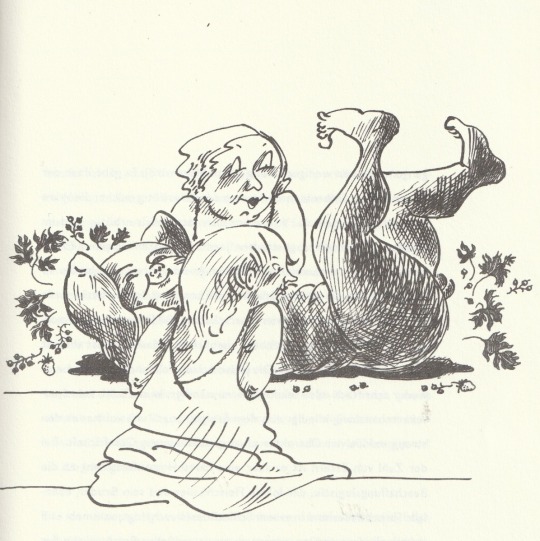
View On WordPress
#Alpeneier#Artemis Ephesia#Artemis Ephesia Stierhoden#Bartolomeo Scappi#Bergaustern#Christa Fuchs#Dumas Père#Durian Gray#Erlauftal Stierhoden Essen#Ethik#F. W. Bernstein#Foodblog#Glocken der Heimat#Gudrun Harrer#Häuptling Eigener Herd#Häuptling Eigener Herd Heft 24#Melar Lucan#Montana Testicle Festival#Mozartkugeln#Rezept Beidl#Rezept Hoden#Rocky Mountain Oysters#Rocky-Mountain-Oysters#Rognons blancs#Schweizer Glocken der Heimat#spanische Nieren#Stierhodenessen#Stierhodenessen Timelkaner Schützenrunde#testicules#The Decadent
0 notes
Text
Artemis Quick Facts
Some of my notes from the books and papers I've read about Artemis.
In the 2nd century at the capital of the Roman province of Asia, Ephesus, Artemis was publicly declared to be "forever the greatest of all the gods".
Her name's etymology is unknown, likely pre-Greek. Her name was popularly believed to mean "healthy", meaning she makes people feel safe and healthy.
Artemis was extremely popular goddess, one of the most popular Greco-Roman gods.
Pausanias notes: "But all cities worship Artemis of Ephesus, and individuals hold her in honor above all the gods…" (4.31.8)
Dr. Rietveld described Artemis Ephesia as an "universal goddess".
Artemis subsumed and was amalgamated with many goddesses, including Kybele, Hekate, and Isis.
She was widely seen as a compassionate and loving god, as she’s always willing to listen and respond to the needs of her people.
She was popularly seen as a goddess of protection and life.
She was famous throughout the Roman Empire for her vivid manifestations, in real life and in dreams.
Hence many sanctuaries, shrines, altars, and temples were built in her honor.
From countless thanksgiving writings she was called "Our Lady".
Her sanctuaries and temples were typically asylum sites.
She's the only Greco-Roman god with the Zodiac on her cult image.
Hence as "Queen of the Cosmos" she has transcendent powers over the cosmos, and Fate.
As Mistress Salvation, Artemis can save her people from their unfortunate fate. It's possible that through the mysteries she can give people a blessed afterlife.
The relationship between Artemis and her worshippers was a divinely directed covenant relationship, born out of genuine affection towards Artemis.
Popularly Called: Queen of the Cosmos, Heavenly Queen, Savior, Our Lady, Mistress Salvation, and Fate Goddess.
Thank you for reading, I hope you enjoy this and learned something new about Artemis.
Sources:
James Rietveld’s “Artemis of the Ephesians”
Mary Gabrielle Galvin "BIOΣ ~ APTEMIΣ"
Richard Oster’s “The Ephesian Artemis as an Opponent of Early Christianity”
Margaret C. Mowczko’s “The Regalia of Artemis”
Paschidis' "Artemis Ephesia and Herakles"
Chaniotis' "Megatheism"
#artemis#greek gods#hellenic pantheon#ancient rome#diana goddess#roman history#anatolia#asia minor#ancient greek#roman mythology#classical mythology#classical period#hellenism#ephesus#ionia#greek mythology
142 notes
·
View notes
Text
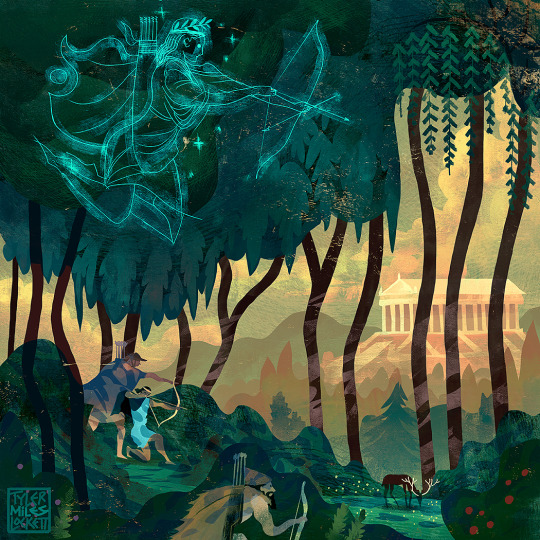
Atalanta #2 "the Way of the Hunter"
Having been successfully rescued and nourished by the she-bear, one day the child, having been left alone, is come upon by a couple of Hunters tracking prey. Seeing the discovery as the will of their hunting patron god, Artemis, the men take the child and dutifully raise her into a skillful hunter, tracker and archer; ever in the service of Artemis.
Because Artemis was the goddess of the hunt, wilderness, and wild animals, she was popular with hunters. And, although the goddess was associated with childbirth and fertility, she herself was celibate, vowing to forever remain a virgin. The hunters, stalking their prey through the forest, wear shawls like cloaks called a Chlamys.
In the background of my illustration we can see one of the seven wonders of the ancient world, the “Temple of Artemis” at the city of Ephesus, (west coast of turkey). Here was a powerful and unique cult, with a more fertility centric Artemis Ephesia, a goddess rooted in Egyptian or Near east great mother goddesses; The site had annual festivals with games and theater performances, where young, single Greeks could seek out marriage partners.
The 2nd century B.C. Greek poet Antipater described it thus; “I have set eyes on the wall of lofty Babylon on which is a road for chariots, and the statue of Zeus by the Alpheus, and the hanging gardens, and the colossus of the Sun, and the huge labour of the high pyramids, and the vast tomb of Mausolus; but when I saw the house of Artemis that mounted to the clouds, those other marvels lost their brilliancy, and I said, "Lo, apart from Olympus, the Sun never looked on aught so grand".
If you've read this far, have a cup of ambrosia on the house!🏺
If you enjoy my art and text posts, please consider supporting me on patreon. 5$ a month will get you work in progress videos, a high res wallpaper image, and collaborate with me and the community by suggesting topics at the end of each month for a poll, where I will paint the winning suggestion as a patreon exclusive illustration. Link: https://www.patreon.com/TylerMilesLockett
#tagamemnon#mythology tag#greekmyths#pjo#percy jackson fanart#percy jackon and the olympians#percyjackson#classical literature#dark academia#classicscommunity#atalanta#artemis#ephesus#aphrodite#goddess#greek#roman#ancient greece#argo#argonautica#medea#calydonian boar#rhea#heroine#archer#ancient wonder of the world#7 wonders#temple of artemis
189 notes
·
View notes
Text
Pausanias, Description of Greece 8. 13. 1 :
"In the territory of Orkhomenos [in Arkadia], on the left of the road from Ankhisiai, there is on the slope of the mountain the sanctuary of Artemis Hymnia (Of Hymns). The Mantineans, too, share it . . . a priestess also and a priest. It is the custom for these to live their whole lives in purity, not only sexual but in all respects, and they neither wash nor spend their lives as do ordinary people, nor do they enter the home of a private man. I know that the 'entertainers' of Artemis Ephesia (of Ephesos) live in a similar fashion, but for a year only, the Ephesians calling them Essenes. They also hold an annual festival in honor of Artemis Hymnia. The former city of Orkhomenos was on the peak of a mountain . . . Near the city is a wooden image of Artemis. It is set in a large cedar tree, and after the tree they call the goddess Kedreatis (the Lady of the Cedar)."
5 notes
·
View notes
Text

first appearance of artemis ephesia before they realised they could have her alone on the reverse how shy she looks trying to hide behind the cista mystica i will protect you.
1 note
·
View note
Text

Khaire 👋🫂
Welcome to my e-altar dedicated to Lady Artemis Potnia Theron 🌙🏹🦌
(complimentary devotional playlist included with your visit ⬇️)
***18+ ONLY. MINORS DNI***
TERFs/Dianic Wiccans are not welcome here.
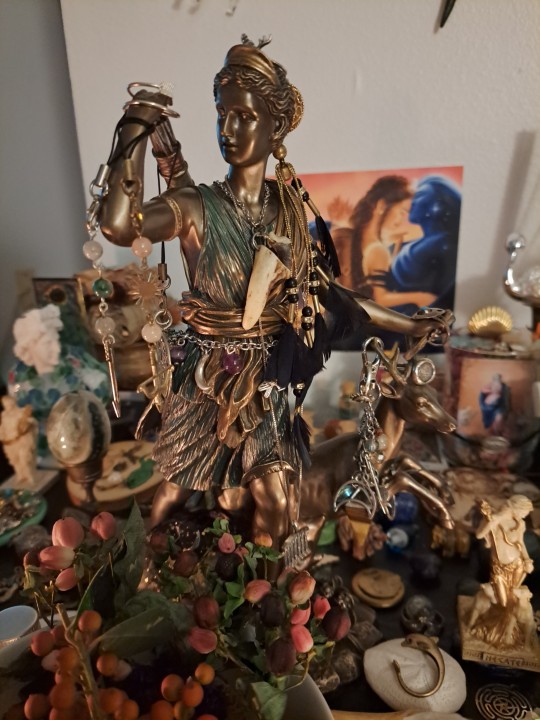

About Me:
🌙 Taylor
🍄 Animist
🪷 They/Them
🦌 Adult (25+)
🏹 Oathbound devotee/worshiper of my beloved Patron, Divine Mother, and Queen; Mistress Artemis-Diana Potna Thea
💜 I honor my Sacred Lady in all her limitless forms and manifestations, including her Ephesian incarnation and the Nymphai
🕊 I am also devoted to Mother Mary Theotokos as a form of hero worship, ancestor veneration, and as an extension of Artemis Ephesia (Artemis of Ephesus) specifically in her 'Queen of Heaven' aspect
☀️ I honor the exalted Apollo(n) Musagetes as my Mother's divine counterpart. For this reason, he is as my Father to me, and I view the Mousai as extensions of him
🎭 I am also a follower of the Liberator, Dionysos-Bacchus Agathus Daemon
I synchronize several deities with my Lady and Queen (this is all personal practice - totally cool if your beliefs differ):
🌕 Selene Aiglê as synchronized with Diana Phôsphoros
🪽 Eileithyia Lysizona as synchronized with Artemis Orsilochia
🏵 Britomartis Diktynna as synchronized with Artemis Pôtnia Therôn (Mistress of Beasts)
🗝 Hekate Anassa Eneri as partly synchronized with Artemis-Diana Trivia
⛰️ Kybele Mater Oreîas as partly synchronized with Artemis Ephesia (Artemis of Ephesus)
Others I follow/honor as part of my worship of Artemis-Diana Sôteira:
🦁 Sekhmet-Bast
🏔 Ninḫursaĝ Ninmaḫ
🌑 Ereshkigal Irkalla
🌾 Demeter Megala Mater
🥀 Persephone Megala Thea



Praise to divine Mistress Artemis, architect of my soul and eternal keeper of my heart.
She of the wolves and of the deer. She of the hunt and of the fire. Swift running archer who haunts the forest wilds and roams in the night. The cresent moon, her silver bow. She who dwells at the mountain peak. She of the Earth and the Heavens.
Bestower of death with her showering arrows. Strong-voiced worker from afar who whispers, “Kneel, or be knelt.” Beautiful empress who bears sword and reins on her golden throne. She of the lake, the marsh, and the harbor. Far-shooter. Lightbringer. Dawn-breaker.
Divine virgin, pure and revered, who soothes. Celestial midwife who nurses the young and patron of childbirth. She of the hymns and pastures. Singer of divine songs and leader of the dance. Sweet-garlanded lady of clamors. She of the white bird, the toad, and the berry seed. Bright goddess.
Beloved and loving high priestess of the bear's jaw, whose hymns only beasts can sing. Willow-bound and royal of cedar, walnut, and laurel. Immortal torch-bearer. Ancestral guardian who stands before the door.
Goddess queen of beasts and nymphs. Maiden. Death. Animal. Feral child. Holy mother. Praise be to Lady Diana, deliverer and savior.




Images:
***(user box by Aterios)***
My altar c: / Quote fragment from Sappho / Fountian of Artemis (Diana) of Ephesus at Villa d’Este / Artemis in the 'Pastoral' section of Fantasia (unknown gif maker) / Diana's Bath by Louis Devedeux / Fountain of Diana and Actaeon / Quote Fragment from Ursula K. Le Guin / Detail of Artemis depicted as the Potnia Theron (Lady of the Beasts) from the Francois Vase / Diana the Huntress by Guillaume Seignac
#sorry for the long post#original intro post got taken down#info post#personal practice#personal#artemis#potnia theron#hecate#hekate#apollo#apollon#hellenic pantheon#hellenic polytheism#hellenic gods#hellenic community#hellenic worship#pagan#deity work#deity worship#deity prayers#long post#marian devotion#norse pantheon#celtic pantheon#roman polytheism#devotional polytheism#christian polytheism#info page#blog info#religious syncretism
95 notes
·
View notes
Text
“Artemis could, and did, as sculptures of Artemis Ephesia prove, exist as the seemingly paradoxical virginal mother, representing care and nurturing femininity in a context completely removed from questions of sexuality. Different from all of these, however, are Running Artemis and Artemis Fastening Her Mantle. Running Artemis, an original Greek marble dated between the late 2nd century BC and the 1st century AD, has come down through the centuries in pieces, and only the torso to the knee joints remain, currently in the collection of the Saint Louis Art Museum (fig. 5). Despite the apparent paucity of the sculpture’s complete form, what is left offers more than enough information about how the sculptor sought to portray Artemis’s femininity. Originally running, as the name suggests, the stumps of the arms and legs suggest a wide range of motion. The quiver strap which still separates and underlines her breast suggests that possibly she held a bow, though her pose and action beyond running are unclear. Above all this, however, it is the drapery, or rather, its defiance of normal conventions of fabric, is what begs notice. Despite being carved in stone, the fabric of Artemis’s short chiton seems as delicate and thin as tissue paper. The ripples and folds of the fabric cascade across her figure more like water than anything else, barely concealing the flesh that they cover. Her nipples and areolae are almost visible, her belly-button is clear as day, as is much of the toning on her stomach, and her legs stand out almost perfectly. Her genital region is only spared this treatment by a cleverly placed undulation in the fabric. The combination of garment and form exudes a subtle sexuality – one that, in the context of depictions of a virgin goddess, is nearly unbelievable. As heroic nudity emphasized masculinity, clothing, too, could be used to emphasize feminine form and beauty.31 This treatment of fabric and form, wherein the body is “covered with a tunic of thin material clinging close to the forms – wetted drapery” revealing almost everything, is accepted and common on depictions of nymphs, nereids, and Aphrodite, to name a few, but rarely so with Artemis.32 Even so, some sculptors did seek to portray Artemis as physically desirable, as Artemis Fastening Her Mantle supports.
Associated with Praxiteles, this work is also known as the Diana of Gabii, and has been called “one of the most attractive works of ancient art” by viewers of it at its current home in the Louvre (fig. 6).33 While it is again a Roman copy after a Greek 4th century BCE original, the statement can hardly be argued. Fully intact, this vision of Artemis presents her in a more sedate and domesticated moment as she fastens part of her clothing about her shoulder. The curve of her neck and shoulders is revealed as her hair is bound upon her head by a fillet. Again she wears the short chiton, but this time it slips artfully and somewhat tantalizingly off her shoulder, revealing just enough flesh of the breast to make the viewer wonder what more there is. Delicately she twists her arm, holding the closure of her mantle, or himation, between the thumb and forefingers in a way that allows the rest of her fingers to fan out in a graceful arc. There is a sense that this moment is private, that the viewer is intruding on a moment of readying for the day. Absent are the bow and quiver. In this moment, Artemis is desirable, elegant, and comely, posed identically to Aphrodite on Athenian red-figure oenochoe, attributed to Polion or the Heimarmene Painter and currently in the collection of the Vatican (fig 7).34 These two sculptures prove that, to some sculptors, Artemis’s “virginity is not asexual like that of Athena, but is highly sexualized,” as a maiden before marriage is considered ripe for the picking.35 Rather than emphasizing Artemis’s power, prowess, or divinity, they emphasize her form and her delicacy, adhering to an ideal that places women in the confines of the home.36 As many have observe, “Artemis’s virginity … seems to invite violation,” her wildness, domestication.37 Rapes, both attempted and successful, are all too common in myths of Artemis, and often extend to her followers.38 While in mythology these incidents are regarded as a “heinous assault” punishable by justly horrible death, sculptors faced no such dangers.39 Just as Homer infantilized Artemis on the battlefields of Troy and portrayed her as a mewling weakling in the face of Hera’s tirades, these artists remove her sexual agency, devaluing her choice of eternal virginity by making her an object to be visually consumed for pleasure..”
- Laura G. Waters, Artemis: Depictions of Form and Femininity in Sculpture
0 notes
Photo

..
#ancient world#naples#sculpture#archaeological museum#artemis#traveling#neapel#original photography#napoli#vertical#museum#travel#reise#greek sculpture#sculptur#original photographers#artemis ephesia#travelling#reisen#ancient greece#diana#goddess#Göttin#greek mythology#griechische mythologie#ancient#antik#archaeology#archäologie#marble
18 notes
·
View notes
Photo
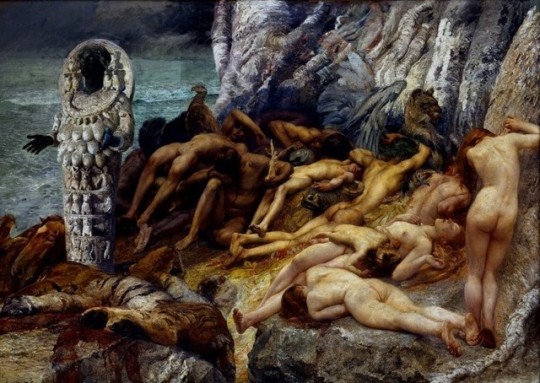
Giulio Aristide Sartorio
- Artemis Ephesia and the slaves
1890
#bahat even#Giulio Aristide Sartorio#diana#arthemis#artemis ephesia#diana ephesia#mythology#greek mythology#romanticism#goddess#landscape#seaside
14 notes
·
View notes
Text

Artemis Ephesia from Pompeii, Italy
160 notes
·
View notes
Text
This might be useful to some. Some of the articles on her site are very Wiccan/Goddess religion-y which icks me out a bit, but I can say she's probably not a TERF based on her Artemis Ephesia podcast episode.
20 notes
·
View notes
Text
I find it so interesting that in book 4, Artemis and Holly are chased by trolls through a fairy-made replica of the wonders of the ancient world, as Opal thought it'd be amusing for them to get killed on the steps of the faux-Temple of Artemis.
Specifically, because of the history surrounding the monument — despite the temple's name, it's not technically dedicated to the Greek goddess Artemis.
The goddess Artemis of Ephesus (Αρτεμις Εφεσία), known also as Diana of Ephesus, was a supreme deity of the city of Ephesus. Before the Greeks took over her cult, she was a local Asia Minor goddess who was more similar to Near-Eastern and Egyptian goddesses than to the Greek Artemis. In the earliest period of goddess’s cult, presumably from the end of the 10th century BC, she was an unknown goddess, venerated as the mother of Ephesus, which was later, upon the arrival of the Greeks, equated with the Greek goddess Artemis.
- From Nadežda Gavrilović Vitas' "Artemis of Ephesus"
Essentially, the Temple of Artemis was a monument to the fascinating power of syncretic beliefs in the ancient world; the Ephesian Artemis is a fascinatingly local, hybrid deity — a version of Artemis who, in truth, was more so a renamed version of a preexisting goddess.
While the Greek Artemis was a rigid figure associated with the hunt, who was borderline hermitic, who was an eternal maiden, the Ephesian Artemis was hermetic -- a mystic figure associated with bacchanalian festivals, young love, and protection of the city of Ephesus.
The dimension of her cult dedicated to magic is one of the more notable characteristics of her followers:
The adherents of the goddess considered her a mistress of the Underworld and the one who held power over the demons of the dead and the demons of Nature. She was also connected to magic and magic rituals, which is implied by the Ephesian magic letters known as Ephesia Grammata, written on the feet, belt or the crown of the goddess’ sculptures and statues.
- From Nadežda Gavrilović Vitas' "Artemis of Ephesus"
The way the lore of the Ephesian Artemis manages to capture the characteristics of the People (magic, "the underworld", nature, etc) while also having a connection to Artemis' namesake (the Greek Artemis) is just... so much fun.
65 notes
·
View notes
Text
Artemisia: The Holy Days of Artemis
In Ionia and Crete had their New Year’s on the spring equinox, the month Artemisios (Artemision in Ephesus), which is associated with the Zodiac Aries. Later during the reign of Augustus, the New Year’s was changed to Libra, the month of his birthday.
Regarding festivals and celebrations, according to Mary Galvin in her “BIOΣ ~ APTEMIΣ” described common elements of Artemision festivals were “…eating and drinking, singing and dancing, precessions, competitions and sacrifice were common activities despite local variations…” (Vol.1-1, page 243). Night time festivals for Artemis were quite common.
The 6th day of every month is devoted to Artemis. Also in Ephesus, every night of the full moon and new moon is an Epiphany celebration that featured an appearance from Artemis to people celebrating.
Artemision
Zodiac: Aries; Spring Equinox; 2023: March 20th – April 20th
Also known as Artemisios. The New Year starts off with a bang! In ~162 AD it was declared that the month, named after Artemis is sacred and no public business will be allowed.
An annual pan-Ionian festival, “Ephesia”! It was held at Panionium from the 6th to 5th centuries BC, then it was moved to Ephesus. Nocturnal festival full of competitions and banquets involving the youth. It was also characterized by choral dancing and other musical competitions. Women and children were also especially encouraged to participate.
Artemisia festival. Month long festival with processions, sacrifice, music, dancing, and competitions. It featured a torch race and winners dedicated their success to Artemis.
A marriage festival was featured in Xenophon’s Ephesian Tales. Young men and women from and around Ephesus choose their spouse. After the young adults found their partner they’ll dress up in elaborate and colorful clothes and go on a procession to the Temple of Artemis. They are accompanied with music and dancing, sang hymns to Artemis with her images surround the procession. At the Temple they newlyweds confirmed their marriage with a sacrifice to Artemis.
The beginning of Spring marks the opening of the port of Ephesus after it was closed during winter. At the harbor an image of Artemis was brought from the Artemision and cast it into the water. They believed that her power would protect sailors, navigators, and people traveling on the sea. Artemis Ephesia was known as the “Queen of the Sea”.
Numerous other festivals were observed throughout the month making the entire month practically a “Holimonth”, as the days were called “Holy Days of Artemis”.
Richard Oster states: “We can be sure that this was one of the largest and most significant celebrations in Ephesus’ liturgical calendar”.
The observation of the month was taken very seriously, even Roman officials weren’t immune to criticism when some of them were seen as impious towards Artemis’ holy days. The numerous festivals brought many tourists that brought significant income to Ephesus.
Lastly, on the sixth day the there’s the Elaphebolia. Hyampolis celebrated their victory against the Thessalians, thanks to Artemis. People enjoyed offering and eating deer-shaped cakes with honey and sesame.
Notes taken from:
Riteveld’s Artemis of the Ephesians
Mary Galvin’s BIOΣ ~ APTEMIΣ
2023 Dates: https://www.yourzodiacsign.com/calendar/2023/
#artemis#greek gods#ancient rome#diana goddess#roman history#anatolia#asia minor#ancient greek#roman mythology#classical mythology#classical period#hellenism#ephesus#ionia#greek mythology#ephesians
48 notes
·
View notes
Text
THE TEMPLE OF HADRIAN AT EPHESUS

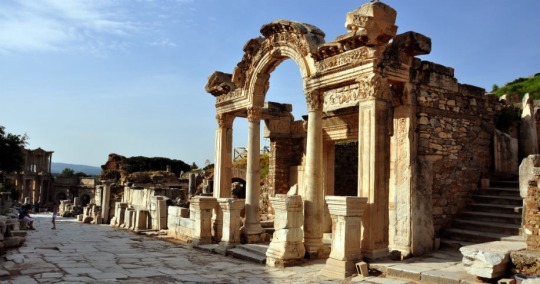

As an inscription on the archivolt states, the asiarch of Ephesus, Poplius Vedius Antoninus Sabinus, dedicated the small temple in the center of the city to Artemis Ephesia, the reigning Emperor Hadrian and to the demos of Ephesus.
The temple was originally built to commemorate Hadrian’s first visit to Ephesus in AD 124. The temple’s dedication to the living emperor is therefore purely honorific, recognizing his benefactions to the city, and does not reflect the establishment of an imperial cult (the ruins of a much larger structure discovered in Ephesus in the 1980s are probably the official temple of the deified Hadrian).
As seen. today, the temple consists mainly of the portico which was excavated and reconstructed in the 1950s. The profusely-decorated broken pediment and arcuated lintel are hallmarks of the baroque taste of the eastern provinces.
The structure was severely damaged by an earthquake in AD 262. Its rebuilding was completed during the early years of the tetrarchy, as evidenced by the four plinths placed in front ot the pronaos which bear the names of Diocletian, Maxentius, Constantine Chlorus and Galerius. The four marble reliefs, depicting the founding of Ephesus were removed from another monument and reused in the portico as part of a rebuilding campaign following yet another earthquake in the 370s.
The temple underwent a complete restoration in 2012/14.
92 notes
·
View notes
Photo



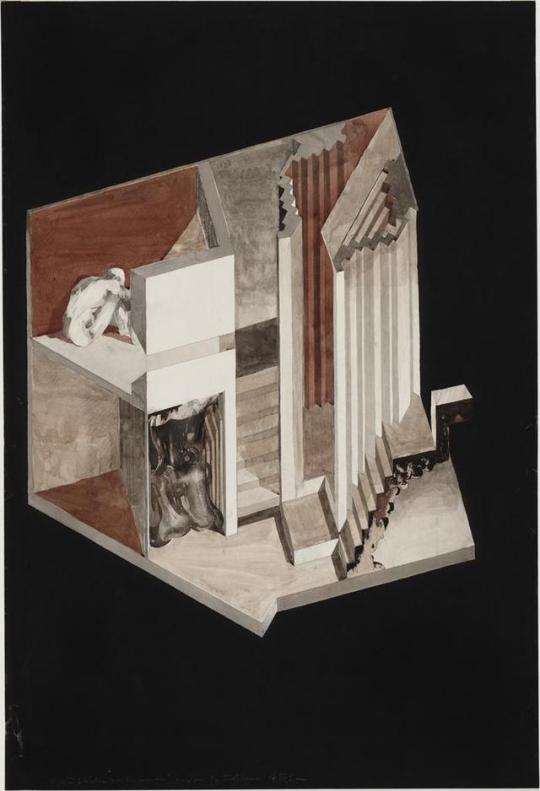


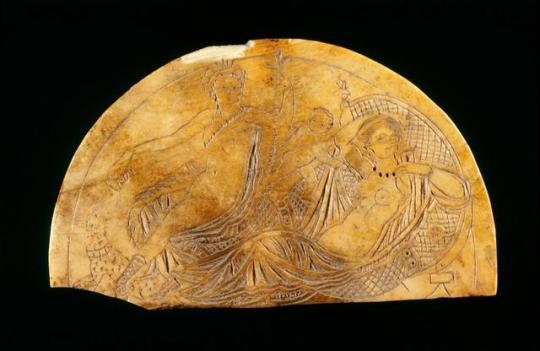
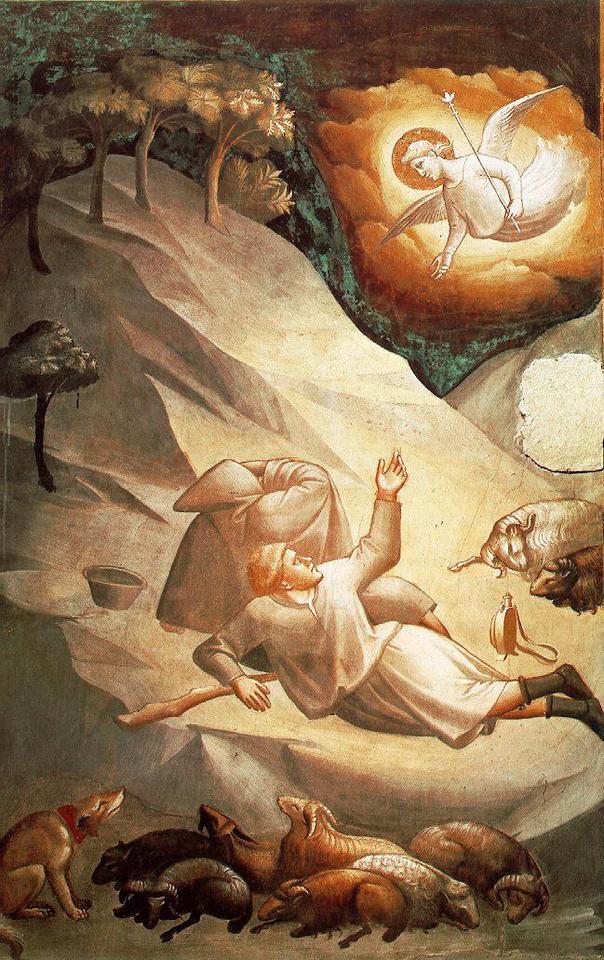

By Jean Marie Carey
On 28 May, 585 BCE, a solar eclipse occurred. The astronomical phenomenon had been calculated and predicted by the Greek philosopher and scientist Thales, and because of the certainty of his observations and notes, it is one of the cardinal events of the ancient world from which other dates can be calculated. The seeming magical and rare nature of the eclipse and its association with the divine naturally aligned the brief disappearance of the sun with art and religion.
The solar disc behind the head of the Ephesian Artemis is thought to represent the eclipse, as the four lions to her right and left carry the sun across the sky. The celestial affiliation connects this Artemis to the Roman Diana though unlike the maiden Diana the Ephesian goddess was one of fertility and fruitfulness. However, the life-size Roman statues of Artemis Ephesia do not display rows of breasts but instead a sort of garment padded with seeds, corn, and pendants wound with bands of ribbon.
In his Annunciation to the Shepherds in the Basilica of Santa Croce in Florence, Taddeo Gaddi represented divine radiance using light effects that he had seen during the eclipse of 16 July 1330 — a viewing that left him partially blind. Raphael based the eerie corona in the scene of Isaac and Rebecca Spied on by Abimelech on the eclipse of June 1518, which he also, though without injury, had witnessed himself. The painting interprets Genesis 26:8 in which Isaac — who called his wife, Rebecca, his sister – embraces Rebecca while Abimelech, king of the Philistines, spies on the couple from his window. The eclipse makes a metaphor of the impenetrability of the darkness.
Subsequent appearances of the eclipse in Italian art are also interpretive, such as landscape painter Ippolito Caffi’s oil painting View of Venice with the Eclipse of 8 July 1842, which depicts one-quarter of the sky brightly lit and three-quarters of it dark, a scientific and observational inaccuracy that nonetheless does show an eclipse as a process involving dynamic changes in light.
Architect Gaetano Pesce's drawings of the Period of Contaminations, Housing Unit for Two People, are two works designed for his installation in The Museum of Modern Art's 1972 exhibition Italy: The New Domestic Landscape. Pesce's work presented a third-millennium archeologist's discovery of an underground southern alpine city into which people had retreated to avoid the imagined radiation from an eclipse. Ettore Sottsass used The Planet as Festival series to depict the eclipse as harbinger of a utopian land where all of humanity would be free from work and social conditioning. In his futuristic vision goods are free, abundantly produced, and distributed throughout the globe. The Planet as Festival drawings are black-and-white studies for hand-colored lithographs. They depict such "super-instruments" for entertainment as a monolithic dispenser for incense, drugs, and laughing gas set in a campground, rafts for listening to chamber music on a river, and a stadium to watch the eclipse.
Reference: Jay M. Pasachoff and Roberta J. M. Olson. “Art of the Eclipse: As the Next Solar Eclipse Approaches … How Artists from the Early Renaissance Onwards Have Interpreted the Phenomenon.” Nature. 17 April 2014. Vol. 508 (7496), p. 314 (2).
Ippolito Caffi, View of Venice with the Eclipse of 8 July 1842, c. 1843. Wikimedia Commons.
Antoine Caron, Dionysius the Areopagite Converting the Pagan Philosophers, c. 1570. The J. Paul Getty Museum, Los Angeles.
Gaetano Pesce, The Period of Great Contaminations: Housing Unit for Two People, axonometric section views, 1971-1972. Gouache, watercolor, and graphite with scoring on paper. The Museum of Modern Art, Architecture and Design Collection, Nrs. 1221.2000; 1222.2000.
Ettore Sottsass. The Planet as Festival: Study for Rafts for Listening to Chamber Music, 1972-73. The Museum of Modern Art, Architecture and Design Collection, Nr. 1297.2000.
Ephesian Artemis, Statue (alabaster, gilt; bronze head, hands, feet), Second Century. Museo Archeologico Nazionale di Napoli, Nr. 6278. Roman copy of a Hellenistic original. Formerly in the Farnese Collection.
Half-Moon Plaque with Dionysos, Ariadne, and Eros, c. 350, Byzantium. The Walters Art Museum Museum, Nr. 71.1127.
Tadeo Gaddi, Annunciation to the Shepherds, c. 1335. Basilica of Santa Croce, Florence.
Raphael and his workshop, Isaac and Rebecca Spied upon by Abimelech, 1518–19. The Vatican Palace.
Further Reading: Elly Rachel Truitt. Medieval Robots: Mechanism, Magic, Nature, and Art. Philadelphia: University of Pennsylvania Press, 2015.
Mary D. Garrard. Brunelleschi's Egg: Nature, Art, and Gender in Renaissance Italy. Berkeley: University of California Press, 2010.
#eclipse#solar#sun#celestial#astronomy#ancient world#artemis of ephesia#artemis#diana#Ippolito Caffi#Ettore Sottsass#Gaetano Pesce#raphael workshop#raphael#italian#art#italian art#art history#otd#taddeo gaddi#renaissance#byzantium#coptic egypt
80 notes
·
View notes